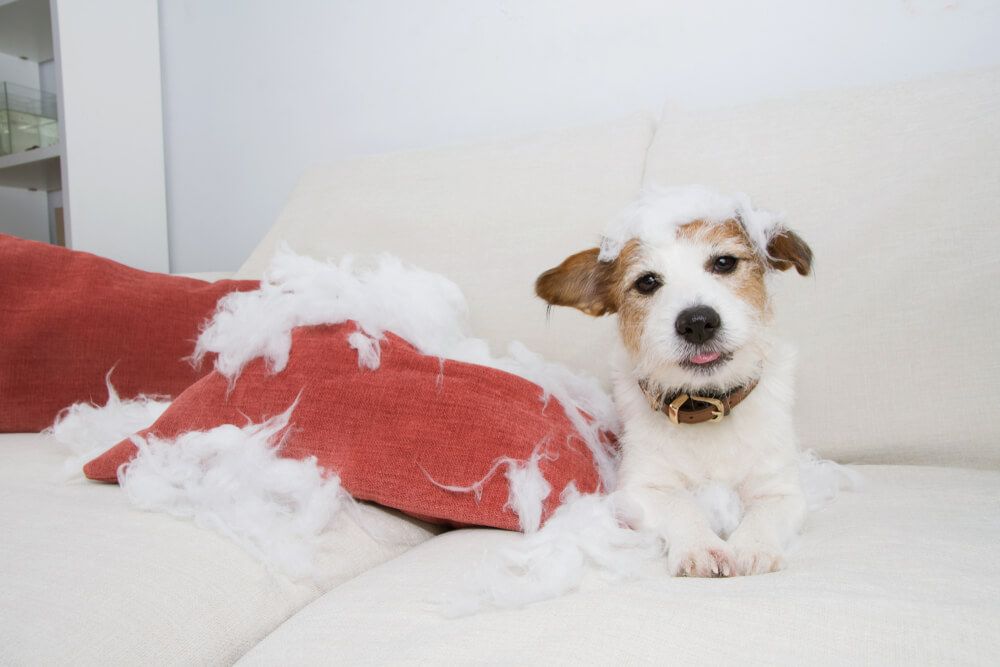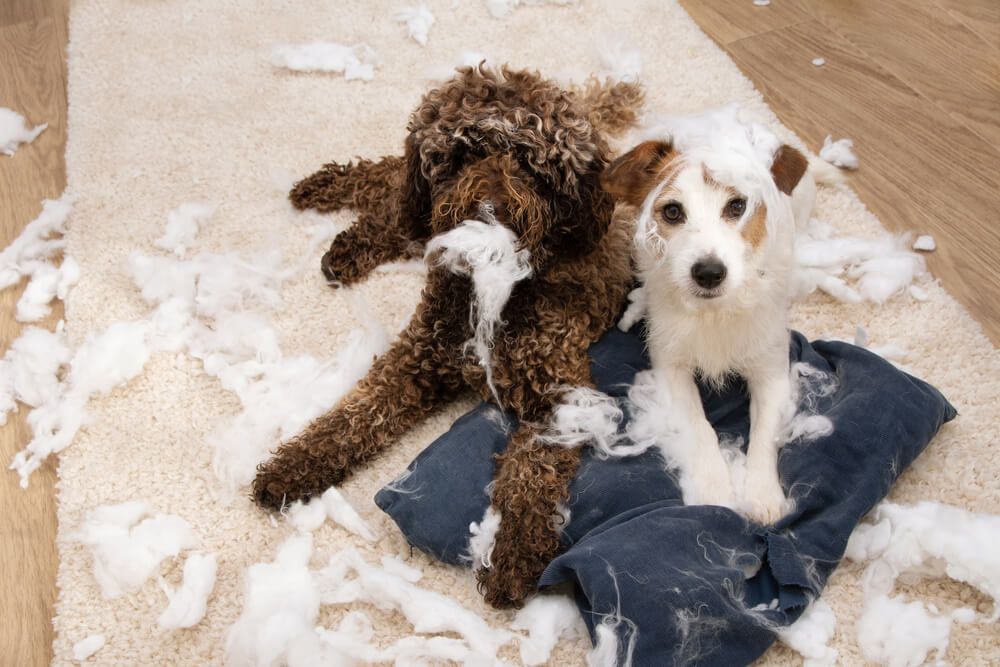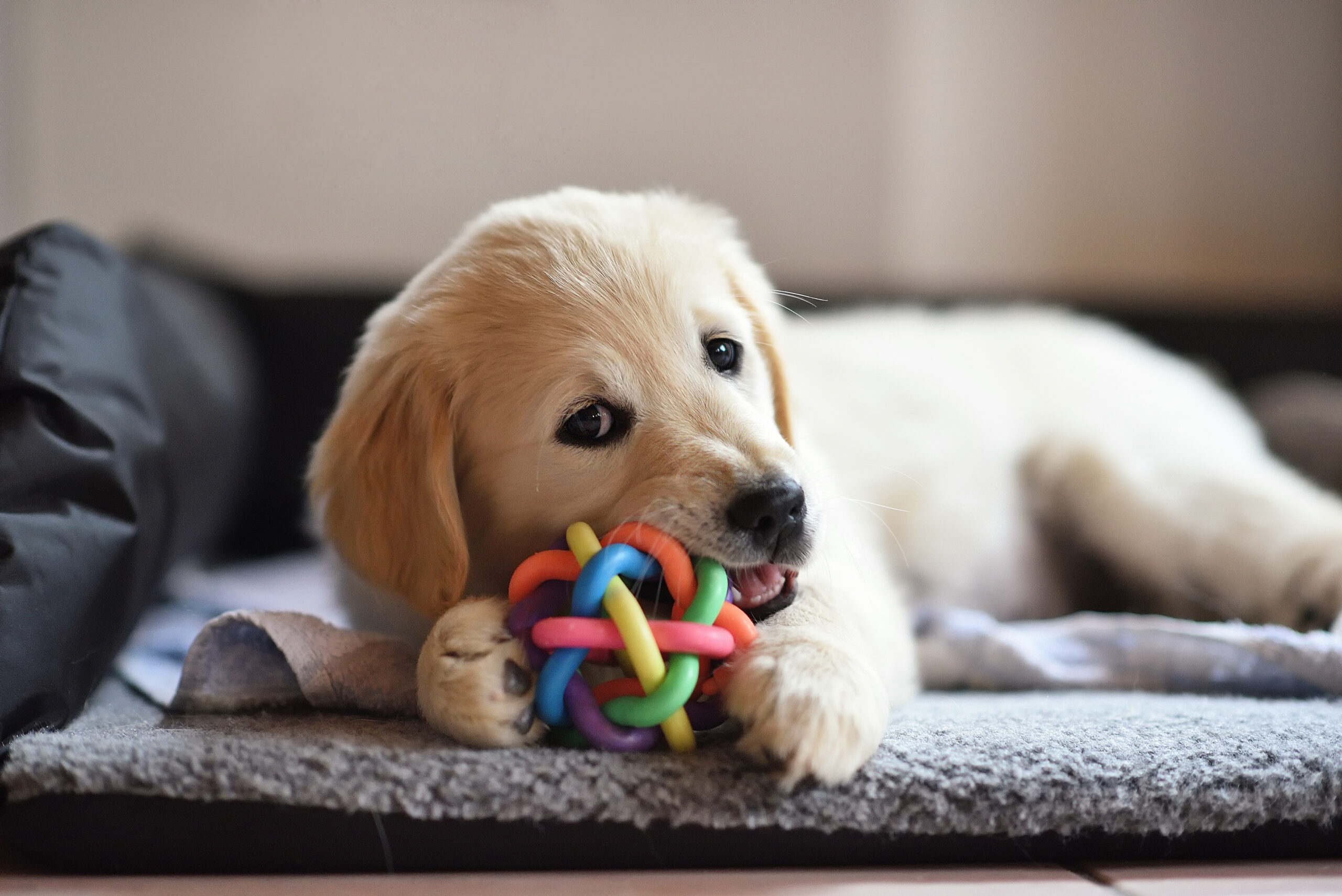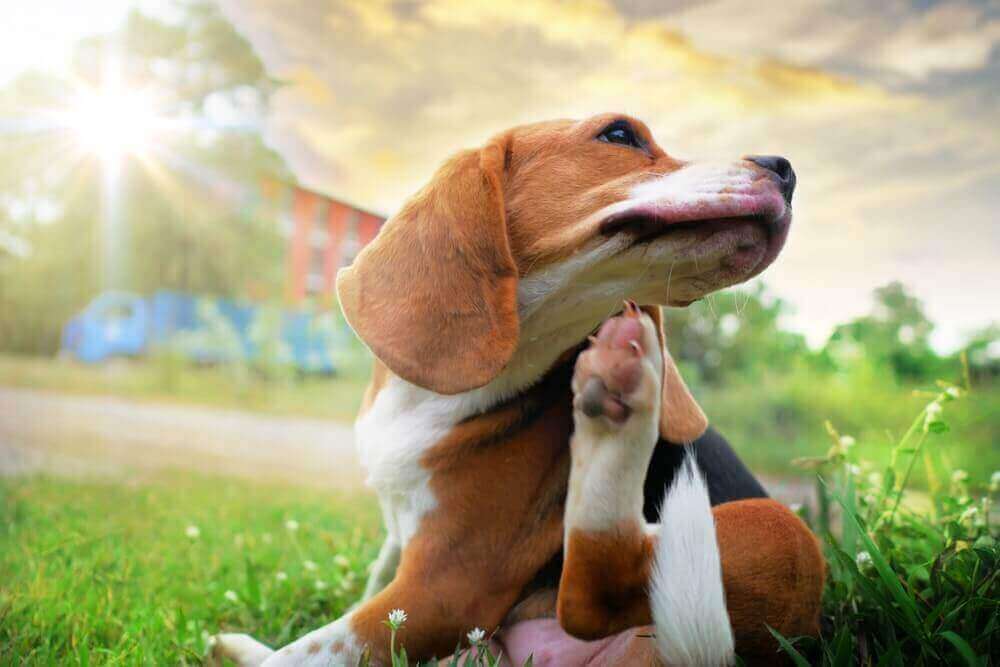Hey Ollie blog readers! We’re offering you an exclusive 60% OFF your starter box! Try now!
Congratulations on your new puppy! By now, you’ve hopefully bought all the supplies your puppy needs, including a crate, treats, fun toys, and some delicious food. But you may be wondering what else you need to do to keep your innocent little puppy safe from everyday dangers and protect your home from your cute-but-curious puppy.
To help you, we’ve created a complete 9-step guide to puppy proofing your house or apartment.
Why is Puppy Proofing Important?
Puppy proofing sets your puppy up for success by creating a safe environment that is free from common household hazards that can lead to dangerous emergencies and expensive veterinary bills. In addition to protecting your new four-legged friend, puppy proofing safeguards your valuables and beloved items by teaching you to keep them out of the reach of those sharp little puppy teeth!

1. Declutter Your Space
If it’s on the floor or within paw’s reach, you should assume it will eventually end up in your puppy’s mouth. When puppy proofing your house, summon your inner organizer to determine what stays or goes. But remember—even if an item sparks joy, it may need to do so from a higher, more secure location until your puppy is a mature, well-behaved adult.
- Move the row of shoes you line up near the door, as well as any handbags, baskets, papers, and decorative items that reside on the floor or a low shelf.
- Purchase plastic tote boxes to store these belongings until your puppy understands the difference between your things and theirs.
- Get down on your puppy’s level to ensure you’ve removed all temptations. While that yoga mat in the corner might seem like no big deal, you probably don’t want it marked with puppy scratches, or worse, shredded to bits, followed by an emergency vet visit because the puppy ate a piece.
Ideally, we recommend confining your puppy to a small area at first, such as a puppy playpen with a crate inside or a small room secured with a pet gate. Supervise your puppy any time they have privileges beyond this space. While we recommend puppy proofing your entire home—including garages and outdoor spaces, barring access to some areas (e.g., the kitchen or living room) can reduce how much work you initially have to do.
2. Hide Wires
In addition to decluttering, remove or conceal cords and wires so your puppy can’t chew on them, as this can lead to an electric shock. For power strips, try installing a protective box like this one from DMoose. Remember that puppies can—and will—explore small and forgotten spaces, so check under couches and furniture for any overlooked cords or wires. Use cord protectors designed for children and infants, bundle and secure wires out of reach, or unplug and remove the cords entirely.
If you have children or grandchildren, it can be helpful to remember the measures you took when you childproofed your home. Hide everything you can, use protective covers on open outlets, and keep things on high shelves and tables. If using outlet covers, don’t forget to put them away when you remove them to use the outlet. Even these small plastic plugs can be a coveted toy—and choking hazard—to a curious puppy.
How to Get Your Puppy to Stop Biting
3. Designate Spaces for Shoes and Bags
Every dog owner has a story about their mischievous puppy chewing on their designer shoes or digging scratch marks into their favorite handbag. But this doesn’t have to be you. Keeping your puppy away from the Gucci is as easy as looking up—use hooks or shelves to keep bags and shoes organized and in pristine condition. Instead of kicking off your shoes, place them immediately in the closet, and don’t forget to close the door.
If the unthinkable happens and your puppy sinks their teeth into a beloved item, don’t be angry. Remember, these items look and smell like your puppy’s chew toys—plus they trigger an exciting reaction from you! Stay calm, offer to trade the puppy for a tasty treat, like Ollie Healthy Dog Treats, and resolve to do a more thorough job of puppy proofing.
Puppies are quick to find trouble and require constant supervision. If you or a responsible household member aren’t able to keep your eyes on your puppy, return the puppy to their crate or secure playpen with a safe positive distraction such as a food-stuffed toy.

4. Watch Your Couches, Tables, and Books
Couches, coffee tables, upholstered chairs, and stacked books and magazines are highly tempting for your puppy. Although you can’t remove most of these things from your home, you will want to teach your puppy that they aren’t for chewing.
Carefully supervise your puppy any time they are near your furniture. If they try to chew on something, gently redirect their attention to a puppy-safe toy. Now is also the time to decide what the rules will be for your dog and furniture. If you decide that couches, chairs, beds, and other furniture are dog-free zones, you will need to prevent bad habits and provide clear guidance right away by teaching your puppy to stay on the floor.
5. Temporarily Relocate Throw Pillows and Blankets
While you can’t hide all of the larger furniture when puppy proofing your home, you can corral and conceal your soft goods. Many puppies find pillows and blankets appealing because of their soft texture and embellishments (e.g., tassels, ribbon), and because they smell like you. Remember, puppyhood is temporary but the damage to your expensive decor—and your puppy’s intestinal tract if they swallow the evidence of their mischief—may be permanent.
6. Keep Food Out of Your Pup’s Reach
All food—including yours and the fresh Ollie you serve in your pup’s bowl—should be securely stored in closed containers. Overeating (i.e., food bloat) can make puppies extremely sick, while consuming your favorite human snacks may lead to accidental poisoning or unpleasant gastrointestinal upset.
Puppies’ stomachs are especially sensitive. While some human foods can be great to share with dogs in appropriate quantities, such as certain fruits, cheese, plain unsalted popcorn, spinach, blueberries, and pumpkin, always introduce these foods gradually and one at a time. But remember, not everything should be shared. Dogs should never consume onions, grapes, macadamia nuts, apple seeds, or raisins as these can cause life-threatening complications.
Best Food for Dogs with Sensitive Stomachs
7. Secure Medications, Cleaning Supplies and Other Toxic Substances
Emergency veterinary centers routinely care for puppies who have ingested harmful cleaning products, antifreeze, and over-the-counter and prescription medications, as well as toxic plants and flowers. Sadly, many pet owners don’t realize that these common household items are extremely poisonous to dogs and cats until their pet requires emergency care.
While we recommend posting contact information for the ASPCA Animal Poison Control Center on your refrigerator or near your phone, the best way to prevent toxin exposure is to secure all toxic substances. For example, if you bring plants or flowers into your home, consult the Toxic Plant List to determine whether to keep them out of reach. When you’re outdoors with your puppy, supervise them around your garden or plants. Of course, the best way to protect your puppy is by selecting only dog-safe plants. Learn more about the plants that are toxic to your pup and how to keep them safe from them.
Topical products are another lesser-known household hazard. This includes medicated lotions, deodorants, toothpaste, and cosmetics. Puppies may love the smell of these items and try to lick them off your body—but many human hygiene products contain xylitol—a dangerous ingredient that can lead to severe blood sugar changes, seizures, and death.
8. Remove the Temptation of Trash Cans
Prevent your puppy from trash picking or dumpster diving by storing kitchen and bathroom trash cans out of reach. Kitchen trash may contain food scraps, wrappers, and inedible things such as meat bones—ingesting any of these items could lead to a veterinary emergency such as choking, poisoning, or severe digestive upset, while bathroom trash containing used tissues, dental floss, and feminine hygiene products can lead to intestinal blockages. If you can’t use a compactor or place your trash can in a cabinet, ensure that each receptacle has a secure or locking lid.
9. Keep Up With The Puppy Proofing as Your Pup Grows
Puppy proofing is a big task, but it’s not a one-and-done event. As your puppy grows, you’ll find additional areas you didn’t initially recognize as hazards. Be patient with yourself and make adjustments as needed—what worked fine for your sweet 10-week-old puppy may no longer work for your bold and curious adolescent dog.
How to Give Your New Puppy a Healthy Start
Products for Puppy Proofing Your Home
Gates and Barriers
Gates and barriers are essential tools for restricting your puppy’s access to certain areas of your home, ensuring they stay safe and out of trouble. These products can be easily installed in doorways or hallways, providing a physical barrier that keeps your puppy contained while still allowing you to monitor them. Look for adjustable gates that can fit various openings and are sturdy enough to withstand a curious puppy’s attempts to push through.
Puppy Playpens
Puppy playpens create a secure and spacious area for your puppy to play while keeping them safe from household hazards. These pens are often portable and can be used both indoors and outdoors, allowing your puppy to enjoy fresh air while being contained. Choose a playpen with a solid base and sufficient height to prevent escapes, ensuring your puppy has room to move freely without getting into trouble.
Deterrent Sprays
Deterrent sprays are effective tools for preventing puppies from chewing on furniture, cords, or other items that could be harmful. These sprays typically have unpleasant tastes or scents that discourage unwanted behavior, helping to protect your belongings while training your puppy. It’s important to choose pet-safe deterrent sprays and apply them consistently to reinforce positive behavior as your puppy learns what is off-limits.
Best Practices for Puppy Proofing Your Yard
Your puppy’s world isn’t limited to the indoors, so also secure your yard or outdoor space so your puppy can safely explore and play. Prevent outdoor emergencies and accidents by taking proactive measures such as:
- Fencing your yard or setting up puppy-proof exercise pens
- Inspecting fences and gates for gaps or weaknesses
- Securing gates with latches that close automatically
- Removing or blocking access to tempting mulch or rocks
- Replacing harmful plants with dog-safe alternatives
- Using dog-safe products on your garden (i.e., no snail bait or pesticides)
- Clearing away sticks and debris
- Providing appropriate toys or building a dig pit
Finally, remember the golden rule of puppy proofing—supervise your puppy! Direct supervision ensures you can immediately address problems or mischievous behavior before it leads to something serious. You are your puppy’s guardian and protector, so stay vigilant—and remember, puppies grow up so you won’t have to do this forever!
The Role of Training in Puppy Proofing
Puppy proofing your four-legged friend’s environment is the foundation for keeping them safe, but it doesn’t teach them how to make good decisions on their own. Obedience training is necessary to ensure your puppy grows into a well-mannered adult who doesn’t require full-time supervision or constant management—plus you’ll finally be able to leave your shoes by the door again!
Join a puppy training group class in your area to learn how to teach key skills such as “Leave it,” “Drop it,” “Come,” and “Stay.” When taught through positive reinforcement-based methods, these concepts are highly rewarding for your dog and a great way to build confidence, grow trust, and strengthen your special bond.
Keeping your pup healthy and safe goes beyond training and puppy proofing. Give your new puppy the best it can get with a personalized meal plan with our quiz.


Healthier ingredients,
tailored recipes, delivered
Get 50% of your first box of Ollie’s fresh
delivered meals today!
The Ollie blog is devoted to helping pet parents lead healthier lives with their pups. If you want to learn more about our fresh, human-grade food, check out MyOllie.com.
Tagged As:

The nutrition your dog needs,
the food they want.

Enjoying our articles? Subscribe our Newsletters and get new articles directly to your inbox
You might also like
13 May 2025
8 MINS READ
Puppy Training Guide & Behavior Timeline
Bringing home a puppy is pure magic. It’s also pure chaos—tiny teeth, zoomies, accidents in the house, and moments that make you wonder if you’re raising a future genius or a tiny tornado. …
by Ollie Pets
10 May 2025
12 MINS READ
New Puppy Checklist: Guide To Prepare For A New Dog
Bringing home a new puppy? This checklist covers everything new dog owners need—from essential supplies to training, feeding, and first vet visits.
by Ollie Pets
3 April 2025
9 MINS READ
Home Remedies for Fleas on Dogs: 10 Natural Ways That Actually Work
Wondering what kills fleas on dogs instantly and naturally? If your pup is scratching like crazy, it may be time to take action. In this guide, we’ll show you the most effective home remedies for…







